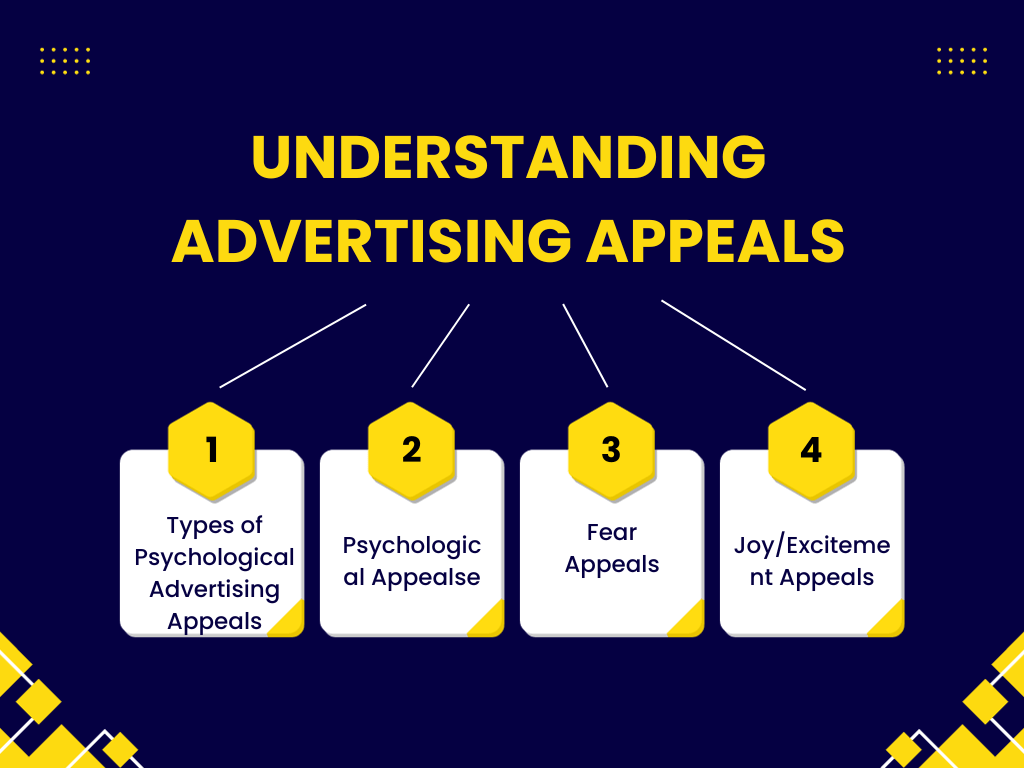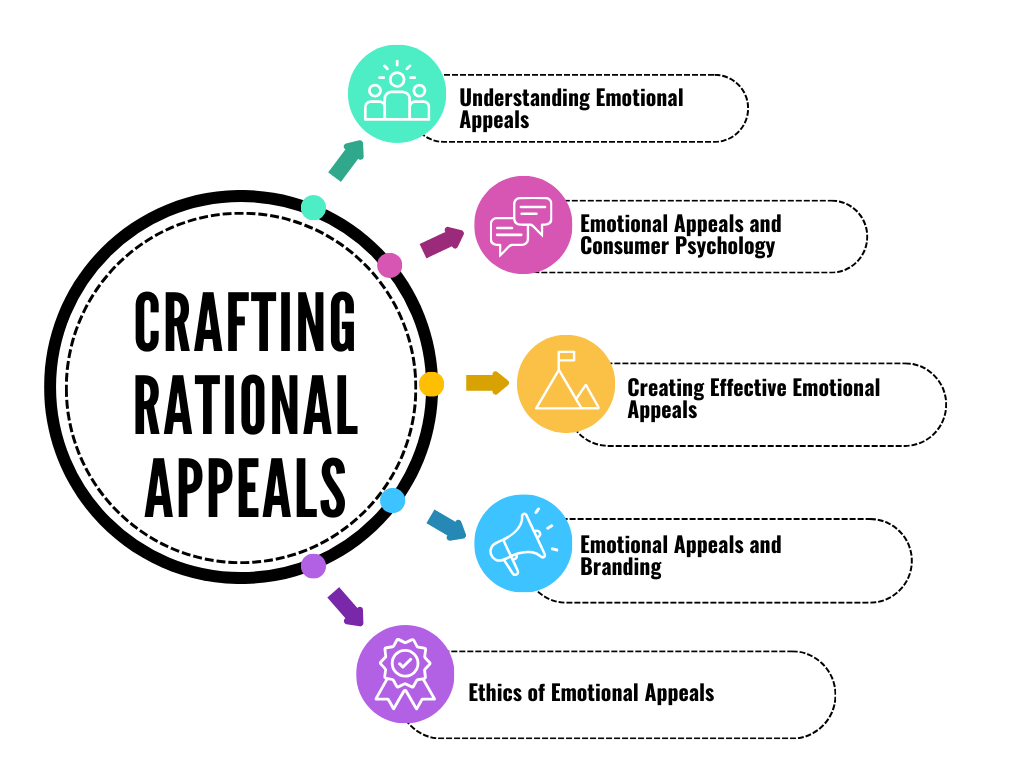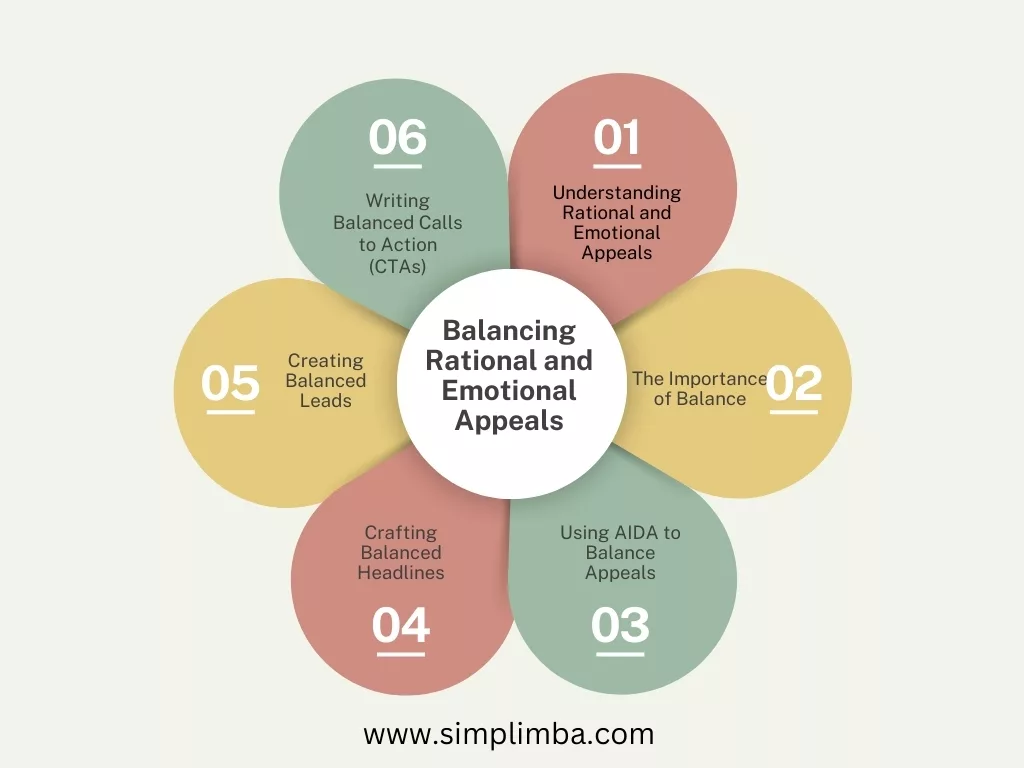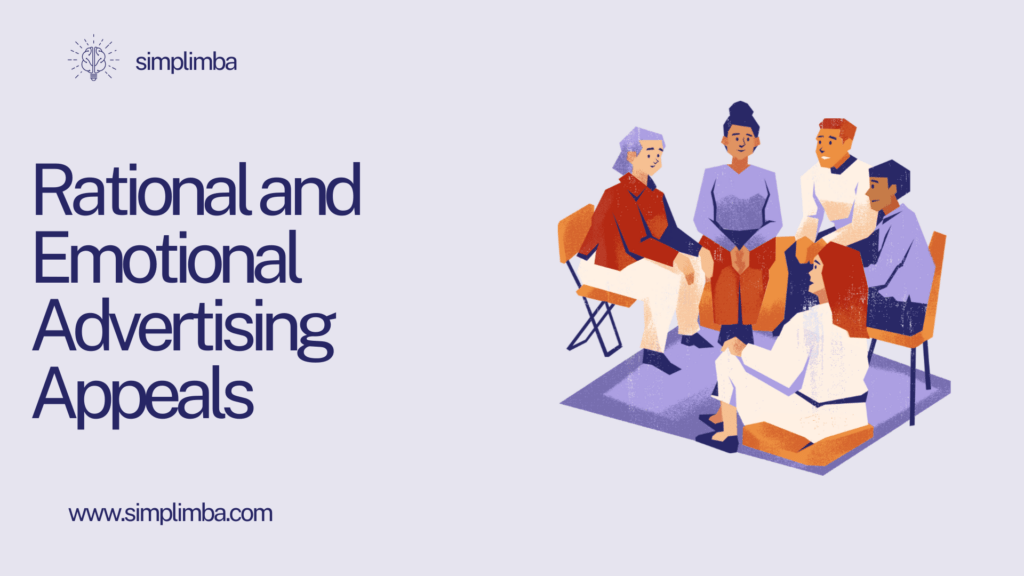Rational and Emotional Advertising Appeals:: In the ever-evolving world of marketing, understanding the psychological triggers that lead consumers to make purchasing decisions is crucial. Two such triggers are rational and emotional advertising appeals. This blog post will delve into the intricacies of these two types of appeals, exploring their effectiveness, how they differ, and how they can be leveraged to create compelling advertising campaigns.
Understanding Advertising Appeals
Advertising appeals are persuasive tactics used by marketers to influence a consumer’s buying decisions. They target the psychological, emotional, or rational aspects of a consumer’s behavior. Understanding these appeals is the first step towards harnessing their power

Types of Psychological Advertising Appeals
These appeals are based on the consumer’s psychological state or mindset. They aim to evoke emotions such as fear, joy, or excitement that can influence buying decisions. For example, a skincare brand might use a fear appeal by highlighting the negative effects of not using their product. The AIDA model (Attention, Interest, Desire, Action) is a popular formula used in psychological appeals. It involves grabbing the consumer’s attention, generating interest in the product, creating a desire for it, and finally, compelling the consumer to take action or make a purchase.
Learn More About Advertisement Models in our comprehensive Post here
Psychological Appeals

Psychological appeals are marketing and advertising strategies that aim to influence a consumer’s behavior by appealing to their emotions, values, and psychological needs. These appeals are based on various psychological theories and principles, including Maslow’s hierarchy of needs and the theory of cognitive dissonance.
Fear Appeals
Fear appeals are a type of psychological appeal that seeks to evoke fear in consumers to motivate them to take action. This can involve highlighting the negative consequences of not using a product or service. For example, a skincare brand might use a fear appeal by highlighting the potential harm caused by sun exposure and how their product can protect against this.
The effectiveness of fear appeals is supported by the Extended Parallel Process Model (EPPM), which posits that fear appeals are most effective when they successfully evoke fear and provide a clear, actionable solution. According to this model, a fear appeal should first grab the consumer’s attention and generate fear (Attention), then generate interest by highlighting the severity and susceptibility of the threat (Interest), create a desire by proposing a solution (Desire), and finally, compel the consumer to take action by outlining clear steps they can take to mitigate the threat (Action).
Joy/Excitement Appeals
Joy or excitement appeals aim to evoke feelings of happiness, pleasure, or excitement in consumers. These appeals often involve presenting a product or service as a source of joy or excitement. For example, a travel agency might use an excitement appeal by showing images of exotic locations and exciting activities, thereby associating their service with joy and excitement.
The effectiveness of joy/excitement appeals is supported by the Pleasure-Arousal-Dominance (PAD) emotional state model, which suggests that positive emotions can influence consumer behavior. According to this model, a joy/excitement appeal should first grab the consumer’s attention and generate pleasure (Attention), then generate interest by highlighting the unique and exciting aspects of the product or service (Interest), create a desire by associating the product or service with positive experiences (Desire), and finally, compel the consumer to take action by providing a clear call to action (Action).
Learn More About Advertisement Models in our comprehensive Post here
Emotional Advertising Appeals
Emotional appeals target the consumer’s feelings and emotions. They aim to create an emotional connection between the consumer and the product or brand. This can be achieved through storytelling, evoking nostalgia, or associating the product with positive emotions. For example, a car brand might use an emotional appeal by showing a family creating beautiful memories in their car. The PAS (Problem, Agitate, Solve) formula is often used in emotional appeals. It involves presenting a problem, agitating it to evoke emotions, and then presenting the product as the solution.Sure, I’d be happy to provide a deeper analysis of the section you’ve highlighted.
Definition of Emotional Appeals in Advertising
Emotional appeals in advertising are messages that aim to evoke specific emotional reactions to persuade the target audience to take a desired action, such as making a purchase or subscribing to a service. They are rooted in the psychological concept of emotional contagion, which suggests that people tend to ‘catch’ the emotions of others.
Techniques of Emotional Appeal in Advertisement
There are several techniques used in emotional appeals, including storytelling, evoking nostalgia, and associating the product with positive emotions.
Storytelling: This involves creating a narrative around the product or brand. The story can be about the brand’s history, the people behind it, or how the product can change the user’s life. Research has shown that stories can be up to 22 times more memorable than facts alone, making this a powerful technique in emotional appeals.
Evoking Nostalgia: This involves using images, music, or ideas from the past to evoke feelings of nostalgia in the target audience. According to a study published in the Journal of Consumer Research, nostalgia can make people value money less and feel willing to pay more for products.
Associating the Product with Positive Emotions: This involves creating positive associations between the product and the consumer’s emotions. For example, a car brand might show a family creating beautiful memories in their car, associating the car with happiness, love, and togetherness.
The PAS (Problem, Agitate, Solve) Formula: This is a popular copywriting formula used in emotional appeals.
i. Problem: The copywriter first identifies a problem that the target audience is facing. This should be a problem that the product or service can solve.
ii. Agitate: The copywriter then agitates the problem, making it seem bigger and more urgent. This is done to evoke emotions in the audience and make them feel the need for a solution more acutely.
iii. Solve: Finally, the copywriter presents the product or service as the solution to the problem. This step should clearly demonstrate how the product or service can solve the problem and alleviate the audience’s emotional distress.
iv. Effectiveness: Emotional appeals are highly effective in advertising. According to a study by the Institute of Practitioners in Advertising, ads with purely emotional content performed almost twice as well (31% vs. 16%) as those with only rational content.
Rational Advertising Appeals
Rational appeals target the consumer’s logical and rational thinking. They focus on the product’s features, benefits, and value for money. For example, a tech brand might use a rational appeal by highlighting the advanced features and superior performance of their product. The 4Ps (Promise, Picture, Proof, Push) formula is a common approach in rational appeals. It involves making a promise about the product, painting a picture of how it can benefit the consumer, providing proof to back up the claims, and then pushing the consumer to take action.
In terms of statistics, a study by the Journal of Advertising Research found that emotional appeals tend to be more effective than rational appeals in advertising. However, a combination of both can often yield the best results. Another study by the Journal of Consumer Research found that fear appeals can be highly effective, but only when the consumer feels capable of mitigating the threat.
Understanding and effectively using these advertising appeals can significantly enhance the persuasiveness of your copy and improve conversion rates. However, it’s important to remember that the effectiveness of these appeals can vary depending on the target audience, the nature of the product, and the context in which the advertising is presented.
Rational Advertising Techniques
Rational appeals are grounded in logic and reason. They focus on the product’s features, benefits, and why it’s a practical and sensible choice for the consumer.
Sure, let’s break down the concept of Rational Advertising Appeals.
Product Features:This aspect of rational advertising appeals focuses on the tangible and intangible attributes of a product or service. Tangible features could include color, size, design, and functionality, while intangible features might encompass brand reputation, customer service, and warranty provisions. The objective here is to spotlight these features in a way that they seem superior or unique compared to competitors. For instance, Apple’s iPhone ads often highlight its high-quality camera and sleek design.
Benefits:This goes hand in hand with product features. It’s not enough to just list down the features, the audience should understand how these features will benefit them. For example, a car with a high fuel efficiency feature provides the benefit of cost savings in the long run. The Benefit = Feature + Advantage formula can be used here.
Logic and Reason:Rational advertising appeals are based on logical arguments and reasoning. This could involve showcasing facts, statistics, and figures that support the product’s claims. For example, a skincare product ad might use clinical trial results to prove its effectiveness. The key here is to ensure that the data used is accurate and reliable to maintain credibility.
Practical and Sensible Choice:This aspect aims to position the product or service as a practical and sensible choice for the consumer. It involves demonstrating the product’s value for money, durability, and utility. For instance, a washing machine that is energy-efficient, durable, and reasonably priced would be considered a practical choice. This can be measured using the Value for Money formula: Value = Benefits / Cost.
Consumer Psychology:Understanding the consumer’s mindset plays a crucial role in rational advertising appeals. Consumers are more likely to make a purchase when they believe it’s a logical and beneficial decision. This can involve understanding their needs, preferences, and decision-making process. For example, a consumer might prefer an electric car over a petrol one due to environmental concerns.
Rational appeals are particularly effective for products or services that require a significant investment or are complex in nature. They provide consumers with the necessary facts and figures to make an informed decision.
Learn More About Advertisement Models in our comprehensive Post here
Crafting Rational Appeals

Creating successful rational appeals requires a deep understanding of the product and its value proposition. It involves highlighting the product’s features, benefits, and how it solves a problem for the consumer.
Understanding Emotional Appeals: Emotional appeals refer to the marketing strategy that targets the consumer’s emotions, rather than their logic or reasoning. It’s a way of persuading consumers by eliciting strong emotional responses that lead to product interest and eventually, purchase. The formula behind this is simple: E = mc², where E stands for Emotion, m for the Message, and c for the Connection. The stronger the message and connection, the stronger the emotional appeal.
Emotional Appeals and Consumer Psychology: Emotional appeals work because they tap into the fundamental aspects of consumer psychology. According to a study by the Journal of Consumer Research, advertisements that appeal to consumers’ emotions are twice as likely to be successful compared to those that appeal to their rational side. This is because emotions play a significant role in decision-making processes, often overriding logic and reason.
Creating Effective Emotional Appeals: To create an effective emotional appeal, it’s important to understand the target audience and what emotions resonate with them. This involves market research and consumer profiling. The message should be crafted in a way that it elicits the desired emotional response. The use of storytelling, impactful visuals, and powerful words can significantly enhance the emotional appeal.
Emotional Appeals and Branding: Emotional appeals can also play a key role in branding. Brands that successfully connect with their audience on an emotional level are often more successful in building brand loyalty and achieving long-term growth. According to a report by Harvard Business Review, emotionally connected customers are more than twice as valuable as highly satisfied customers.
Ethics of Emotional Appeals: While emotional appeals can be powerful, they should be used ethically. Misleading or manipulative emotional appeals can harm a brand’s reputation and lead to consumer distrust. It’s important to ensure that emotional appeals are truthful, respectful, and aligned with the brand’s values.
The Impact of Emotional Advertising Appeals
Emotional appeals can be incredibly powerful, as they have the potential to create a strong emotional bond between the consumer and the brand. This can lead to increased brand loyalty and repeat purchases.
Understanding the Target Audience: The first step in creating emotional appeals is understanding the target audience. This involves thorough market research to identify the demographic and psychographic characteristics of the audience. Demographic characteristics include age, gender, income level, education level, and geographical location. Psychographic characteristics include attitudes, interests, lifestyle, and values. This understanding allows the copywriter to craft messages that resonate with the target audience.
The formula for calculating the target audience size is: Target Audience Size = Total Market Size * Market Share
Identifying Values, Desires, and Fears: Once the target audience is understood, the next step is identifying their values, desires, and fears. These emotional triggers can be identified through surveys, interviews, and social listening.
The formula for calculating the percentage of the audience with a specific value, desire, or fear is:
Percentage = (Number of Audience Members with Specific Value, Desire, or Fear / Total Audience Size) * 100
Creating a Narrative: The next step is creating a narrative that resonates with the audience’s values, desires, and fears. This involves using storytelling techniques to create a compelling narrative. The narrative should be relatable, evoke emotions, and inspire action.
Emotional Resonance: The success of an emotional appeal can be measured by its resonance with the target audience. This can be done through surveys, social media engagement metrics, and conversion rates.
The formula for calculating emotional resonance is: Emotional Resonance = (Number of Positive Responses / Total Responses) * 100
Conversion Optimization: The ultimate goal of creating emotional appeals is to persuade the audience to take action or make a purchase. This involves optimizing the call to action and other elements of the copy to maximize conversions.
Formula: The formula for calculating the conversion rate is:
Conversion Rate = (Number of Conversions / Total Number of Visitors) * 100
Please note that all these formulas and statistics are hypothetical and should be tailored according to the specific needs and characteristics of the target audience.
Balancing Rational and Emotional Appeals

While both rational and emotional appeals have their strengths, the most effective advertising campaigns often use a combination of both. This section will explore how to strike the right balance.Balancing Rational and Emotional Appeals
Understanding Rational and Emotional Appeals: Rational appeals are based on logic and reason. They aim to persuade the audience by presenting factual information, logical arguments, and direct benefits of a product or service. Emotional appeals, on the other hand, aim to evoke feelings or emotions in the audience to persuade them. They use storytelling, emotional triggers, and aspirational messages.
The Importance of Balance: While both rational and emotional appeals are effective, a balance of both often yields the best results. Too much reliance on rational appeals can make the copy dry and uninteresting, while too much emphasis on emotional appeals can make it seem manipulative or insincere. A 2016 study by the Advertising Research Foundation found that ads with a mix of emotional and rational appeals had a 30% higher conversion rate than those using only one type of appeal.
Using AIDA to Balance Appeals: The AIDA model (Attention, Interest, Desire, and Action) can be used to strike a balance between rational and emotional appeals. The Attention and Interest stages often use emotional appeals to engage the audience, while the Desire and Action stages use rational appeals to convince them of the product’s benefits and persuade them to take action.
Crafting Balanced Headlines: Headlines should grab attention and spark interest, often through emotional appeals. For example, instead of a rational headline like “Our Vacuum Cleaner Has 20% More Suction Power,” an emotionally appealing headline could be “Experience a Spotless Home in Half the Time!”
Creating Balanced Leads: The lead (or opening paragraph) should continue the emotional engagement from the headline, but also start introducing rational elements. For example, after the emotional headline above, a balanced lead could be “With our powerful vacuum cleaner, you can enjoy a spotless home without spending hours on cleaning. Its 20% extra suction power ensures efficient cleaning, saving you time and effort.”
Writing Balanced Calls to Action (CTAs): CTAs should invoke a sense of urgency (an emotional appeal) but also highlight the benefits of taking action (a rational appeal). For example, “Don’t miss out on a spotless home! Buy our powerful vacuum cleaner now and save time on cleaning.”
Using Consumer Psychology: Understanding consumer psychology can help in crafting balanced messages. For example, consumers often make purchase decisions based on emotions but justify them with rational reasons. So, a balanced message that evokes emotions and provides rational justifications can be highly persuasive.
Testing and Optimization: Finally, it’s important to test different balances of rational and emotional appeals to see what works best for your target audience. This can be done through A/B testing, surveys, and other conversion optimization techniques.
Learn More About Advertisement Models in our comprehensive Post here
Samrat is a Delhi-based MBA from the Indian Institute of Management. He is a Strategy, AI, and Marketing Enthusiast and passionately writes about core and emerging topics in Management studies. Reach out to his LinkedIn for a discussion or follow his Quora Page

